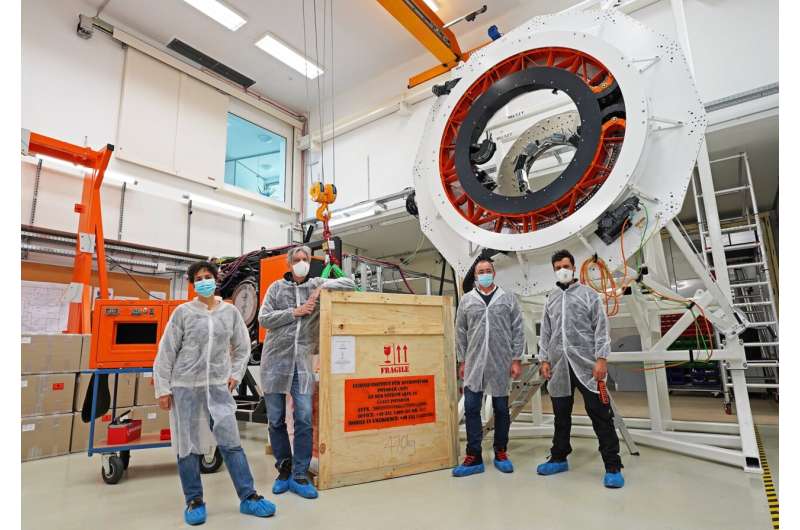Starlight catching system for 4MOST is unpacked in Potsdam

With construction for 4MOST, an instrument for spectroscopic sky surveys, underway, its first major subsystem arrived at the Babelsberg campus of the Leibniz Institute for Astrophysics Potsdam (AIP) and is now being unpacked and assembled. The fiber positioning system AESOP will ensure that 4MOST's optical fibers are able to collect the maximum light of astronomical objects such as stars and galaxies.
The 4-meter Multi-Object Spectroscopic Telescope 4MOST is a survey facility that is being built for the Visible and Infrared Survey Telescope for Astronomy (VISTA), a telescope of the European Southern Observatory (ESO), in the Atacama Desert in Chile under the leadership of AIP. One of the core components of 4MOST is a fiber positioner, called AESOP (Australian-European Southern Observatory Positioner), which was designed and built by the Australian Astronomical Optics (AAO) Department of Macquarie University in Sydney in the framework of ESO's partnership with Australia.
The AESOP system, which is based on innovative AAO technology, includes the positioner with its 2436 fibers, the positioner housing, the electronics and the electronics enclosures. The fibers are arranged in a hexagonally shaped grid and can be pointed very precisely to collect the light from stars and other objects in the sky. The fibers relay the light to three optical multi-object spectrographs that will measure the spectral properties of the observed objects simultaneously, and thus give clues on the chemical structures and movement of different regions of the Milky Way, among other things. The most important requirement for AESOP is that all fibers must be repositioned within one minute with an accuracy of 10 micrometers—about one fifth the thickness of a hair. When the fibers reach their new positions, they are back-illuminated with red light which is recorded by high-resolution cameras to check the positions of the fiber ends before starting a sky exposure. The better the accuracy and speed, the more light from an object will be caught in as little time as possible.
In August, the completed fiber positioner was delivered from AAO in Sydney to AIP in Potsdam. This is the first delivered major component for 4MOST and, once unpacked and reintegrated, it marks the start of 4MOST system integration at AIP's integration hall. "After more than four years of design and analysis work, followed by three years of manufacturing and integration, it was very exciting to receive the finished AESOP for system integration," says Joar Brynnel, Project Manager of 4MOST at AIP. "Test results from Sydney show excellent performance and we are very happy to start testing AESOP in Potsdam and continue the great collaboration with our partners and colleagues in Australia."
Nominally, the plan was for the AAO team to travel to Potsdam and lead the re-integration and test of the AESOP fiber positioner. Due to COVID travel restrictions in and out of Australia, this was not possible. The situation posed difficult problems for the Potsdam engineering staff, who would normally rely on the collaboration with their Australian colleagues for the unpacking and delicate assembly of AESOP. The teams have now devised an alternative plan where the work will be carried out by staff from the European 4MOST partners under the remote supervision of AAO technical staff. This has started with the arrival of a support team from the Max Planck Institute for Astronomy and the Landessternwarte, both in Heidelberg, on 25 October.
Dr. Roelof de Jong, principal investigator of 4MOST, says, "It is amazing to reach the milestone of AESOP unpacking and assembly in Potsdam. The fiber positioner is at the heart of the facility and we can now start assembling and testing the full instrument around it before shipping everything to Chile." The completion of the instrument in Europe and delivery to Chile is currently planned for May of 2023.
"AAO-Macquarie University is proud to engage and work closely with major observatories around the world to deliver innovative new instruments based on the new and emerging technologies, like AESOP, that we are creating," says AAO-Macquarie University's AESOP project manager, Scott Smedley.
The 4MOST consortium consists of 15 institutes in Germany, Australia, France, the Netherlands, Sweden, Switzerland, and the UK, led by AIP. 4MOST will be mounted at ESO's VISTA telescope at Paranal in Chile. The 4MOST design allows tens of millions of spectra to be obtained via five-year surveys, even for targets distributed over a significant fraction of the sky. The instrument will also have enough wavelength coverage to secure velocities of extragalactic objects over a large range in redshift, thus enabling measurements of the evolution of galaxies and the structure of the cosmos. This exceptional instrument enables many science goals, but the design is especially intended to complement three key allsky, spacebased observatories of prime European interest: Gaia, EUCLID, and eROSITA.
Provided by Leibniz Institute for Astrophysics Potsdam





















